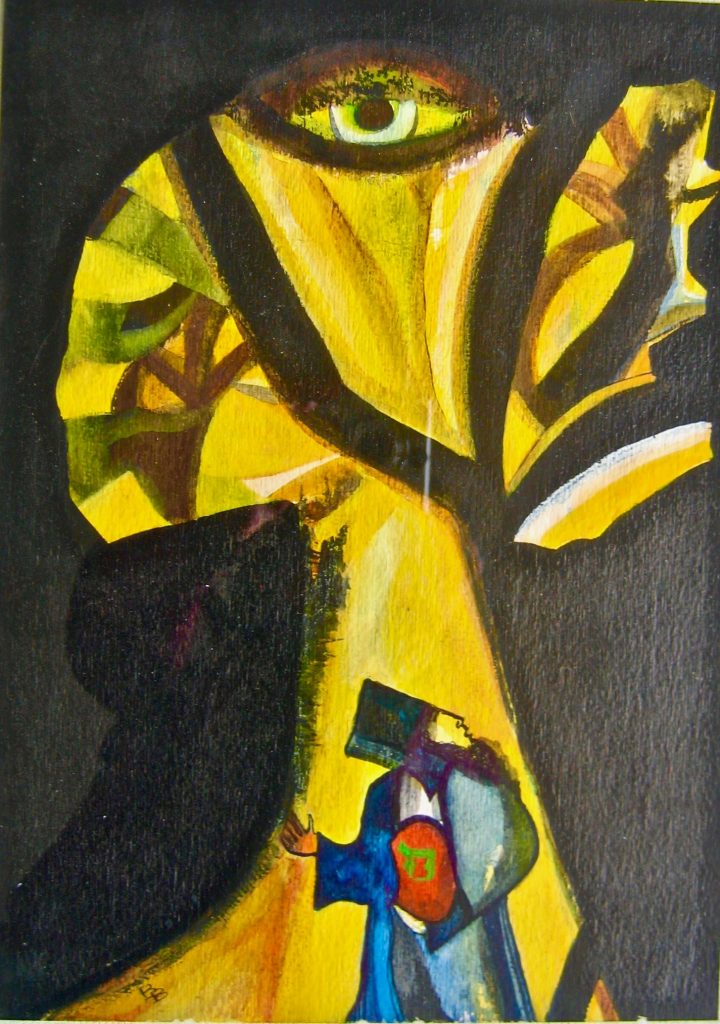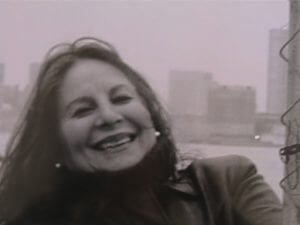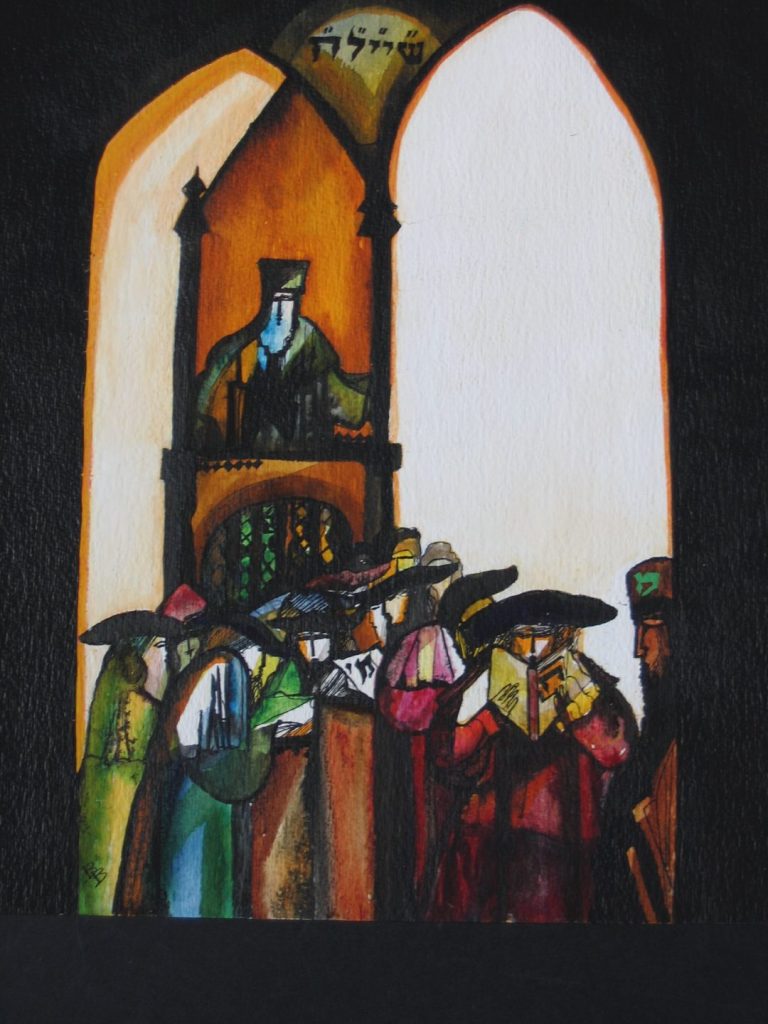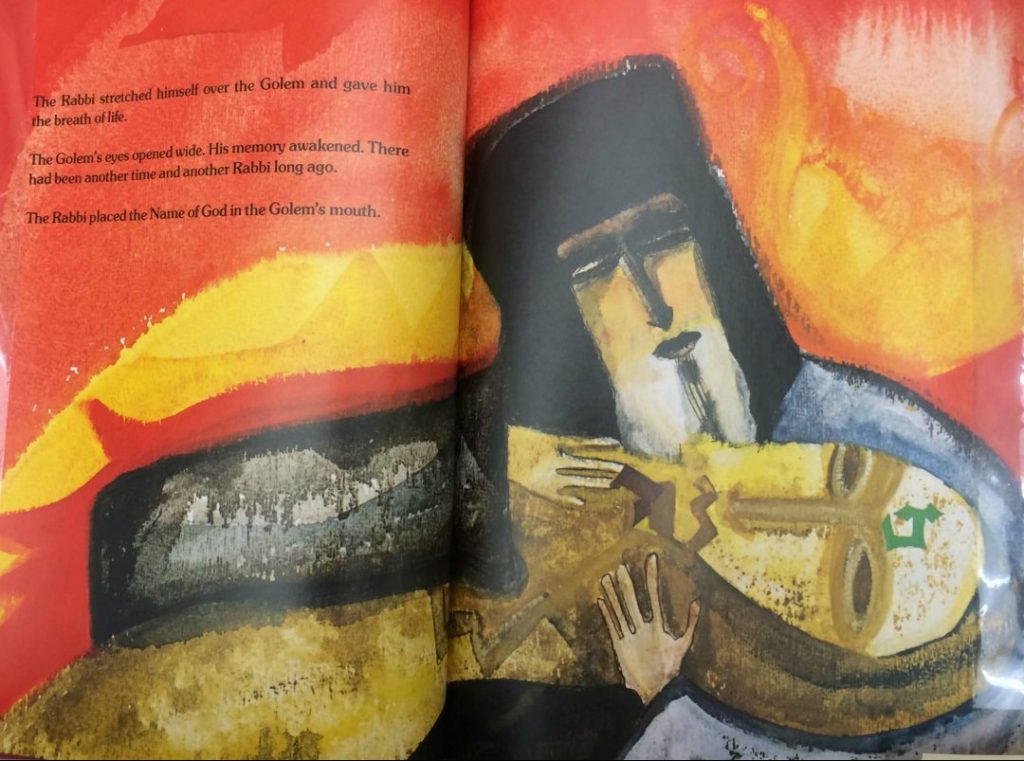Beverly Brodsky: A (Re)Introduction

As a child, instead of dutifully staying with my parents during synagogue services on Friday nights, I’d escape to the Temple’s library. I was always attracted to the same mysterious book, housing colours and imagery that permeated my imagination with both fearful and hypnotic power. The book was a 1977 Caldecott Honor Medal publication illustrating the old Czech variant of a traditional Jewish legend: The Golem. Its images and accompanying words were composed by someone named Beverly Brodsky. I remember her photo at the back: the striking image of a young woman with dark, long hair, a paintbrush in hand leaning over dark strokes of her work on paper. The vision of an artist. That was almost thirty years ago.
In the middle of the COVID-19 lockdown, I pulled out my stolen library copy of The Golem and, not anticipating much, decided to look for Beverly Brodsky.
I found her.
Born in Brooklyn, she studied at Brooklyn College under Ad Reinhardt and Burgoyne Diller. She entered the world of publishing and illustration early, having released three well-received books before The Golem was released, such as The Crystal Apple, Sedna: An Eskimo Myth, and Forest of the Night. She began lecturing as early as 1977, at The Brooklyn Museum, Harvard University, The New School, and Sotheby’s (in connection with NYFA). She continues teaching to this day at Parsons. As an artist, her work has been included in group exhibitions at The Whitney Museum, The Jewish Museum, and the Yeshiva University Museum (New York). So why doesn’t the world know more (or enough) about Brodsky’s nearly six-decade career? That’s about to change. Golem, in Hebrew, comes from the word “golmi” (my “light form” or “raw material”), referring specifically to an unfinished or incomplete human form. Unsurprisingly, it is the gestural experimentation and mystic ruggedness of abstract expressionism that most directly embodies Brodsky’s practice. Spontaneous and supple, with energy supplied by forces both material and metaphysical. Brodsky is living history: part of a rapidly-disappearing generation of artists inspired by everything, funded by the littlest something, and fearful of nothing.
From our Summer 2020 Issue, FRONTRUNNER is pleased to present an exclusive (re)introduction to artist, illustrator, author and lecturer Beverly Brodsky.

“With a heavy heart, he returned to the synagogue”
From The Golem: A Jewish Legend (1976)
Lippincott Williams & Wilkins
Image courtesy of the artist
Let’s begin. Tel me about your childhood, where you’re from, and where you grew up. When did the first inkling of getting into the creative world happen for you?
Okay. Well, I was born in Brooklyn to Eastern European parents. My father was from Riga (Latvia), and my mother was also an immigrant from what was, at that time, part of the Austro-Hungarian empire. I lived in Brooklyn most of my life, up until the age of 20-21, then I moved to the Lower East side. When they emigrated, my parents went to the Lower East Side, like most of the thousands of immigrants – Jews, Italians, Irish – somehow they all wound up on the Lower East Side. My experience much later on living in Brooklyn, which was in Brownsville – we were kind of poor, if you want to say poor. We lived in these tenements. My mother used to listen to the radio, we didn’t have a television for the longest time, and we listened to opera and music of all kinds. We listened to Let’s Pretend. I was very acutely aware of sound rather than imagery, because the only imagery I could find was in newspapers and fashion magazines. I started copying a lot, drawing from that. Then I worked a great deal from my imagination, since we didn’t have a lot of books. I made up all kinds of drawings on what we called the ‘blackboard’ (a slate board.) I loved ballet. My mother used to take me to the ballet, the opera, the museums and so forth, so I started drawing ballerinas from my imagination. Then I started making up images based on stories told on the radio. So my connection with imagery was sound-stories.
Reading was extremely important to me, and whenever I didn’t have anything to do, my mother would say, “Read, read, read, it’s really important to you”, and my father would say, “Knowledge is golden.” So I grew up with a lot of stories told to me at night just before bedtime. Then, when I was old enough, I would go to the library by myself and take out tons of books.
So when did you begin, in your own mind, any sort of formal training in visual art?
When I was 13-14 years old, I was allowed to take drawing classes at the Brooklyn Museum. I remember first seeing my nude male model, and I could hardly do the drawing because I was a little embarrassed, I guess (laughs). In high school I took art lessons, and also along with that I started very young with music lessons on the piano. I studied for about 15-20 years, and started playing Mozart, Beethoven, Chopin, Bach and all the greats. When I got to college, I majored in art, and I studied with Ad Reinhardt, Burgoyne Diller, and Robert Henry. I think this might interest you what happened in Reinhardt’s class…
The first thing he said was, “Speaking to you from the fact that I’m a painter,” he said, “Walk a thousand miles and see a thousand paintings.” That’s the first thing that is important in our case. In other words, have some kind of wide view of what is going on in the world in terms of art, study the masters, constantly draw. I had a drawing class with him where I got a mirror, brought it in, and worked with a self-portrait. In his other class, they had to draw a tree. For the entire semester, one portrait (with maybe a 6H pencil), and all the details of our face. We started out with 15 in the class, then three, two, then one, me. I think he was trying to teach us constant commitment. I think that was an important lesson to learn, because he was coming from a philosophy of zen, he was very connected to the zen view, less-is-more, that sort of thing. Later on, he worked with a kind of minimalist – I hate the word style, I’ll use approach. Style is fleeting, fashion. I don’t quite like that word.
You’re referring to when he moved into color field painting?
Yes, blocks or planes of color, the red on red paintings, the blue-on-blue, the black paintings where you can hardly see the differences in value, there was really no contrast. He minimalizes the contrast so you can hardly see the cruciform in his paintings. Those values are very subtle transitions, so you couldn’t see the cruciform. Towards the ends of their respective careers, Rothko, Reinhardt, and Newman all kind of fell into the abyss of black paintings. While I was painting, I thought, “Let me explore color field painting.” I was experimenting as a student and even after I graduated, I was experimenting with color, alone.
Even at that early stage, you had some semblance of what you determined to be your best working method.
Yes, the method or approach was to use brushwork because it was, for me, a voice. It took on its own personality. Every brush stroke is different from the one you’d made before. I found that interesting, and exciting – I had a passion for that visceral experience, because it was just like the clouds, ever-changing and evolving. That’s how brushwork feels to me. Painting is a process.

Photo courtesy of the artist
Your first illustrated book project was in 1973 or 1974?
The Crystal Apple. I employed a rainbow of colours. I worked with watercolor alone for the book, it had a wide palette of color all throughout. It’s a Russian folktale. I was working with books in order to earn a living. I led a double life, in a sense. I was a painter with a passion for working on canvas, which is very different, very physical. You had to stand up and paint the canvas leaning on the wall. In fact, the first time Reinhardt came to visit my very first studio, I lived on Allen Street in the Lower East Side. What he saw was me painting the walls and painting the doors. He said, “Oh, that’s very interesting. Continue doing that.” He loved the idea that I was branching out and had a very bold approach to painting. It wasn’t just the canvas that I was going to paint on, it was the walls. Whatever surface I could find to paint on, I painted.
You say you were living a double life, you somehow knew that painting wasn’t going to pay for your studio space, wasn’t going to put food on the table. At what point did you figure out how to enter into working with book publishers?
After I graduated from college, I met an editor from Viking Press, George Nicholson, who much later on became my agent. He talked about children’s books in a very interesting way. So there’s a lot of parallel events. As soon as I graduated, I got a teaching job, PS 257 in Williamsburg, Brooklyn. I was teaching the 3rd to the 5th grade, and it wasn’t until much later that I was teaching at a university. First, I studied textile design after I quit my job as a teacher. Somehow that connected to creating books, because it was graphic design. My former husband and I left New York and we went to France for two years. I took advantage of the situation and went to all the museums I could find in the south of France, and Paris, as well.
While I was in college, I had travelled to Mexico City and saw all the wonderful murals by Gabriel Orozco and Diego de Rivera. I was astonished by the scale of those paintings. I think that’s what attracted me to create large-scale paintings. I started doing these when I was in the south of France. I worked at this foundation called ‘La Napoule’ in Cannes. One year in Cannes on the Côte d’Azur, and then the next year we were in Grasse. While we were there, I did a number of large-scale, colorful geometric paintings. I had to leave everything when we left France. I left the paintings there along with all of my music, which saddened me. We had to leave some things behind in order to get back to the States.

Ascending (2009)
Oil on canvas
78″ x 72″
Courtesy of the artist
After you returned to the United States, it seems you’d had this parallel existence of working in book publishing. So was there at any point, years after you left France and after you’d hit this beautiful stride with your publishing, was there any one moment where you were at a crossroads with your practice?
That’s a good question. Interesting you ask that because yes, there was a turning point, and it started in France. I saw a German film called Der Gölem (1920) on French television. It was an expressionist film which worked very well with my philosophy and the idea of painting strokes, rather than flat painting. The spaces in this film were very strange, very distorted. I thought, “My God, tilted space!” But then I went back to painting and thought about Cézanne, and the titled space he used in his still-life paintings of apples, where you’re terrified that something is going to fall off the table. I thought that it was so interesting that Cézanne could do that with space. He changed everything, he was the father of Modernism. When I saw this film, I thought that I had to work on something and create a book about the Golem. This fit very well into my cultural experience. Being Jewish I thought, “Let’s explore this.” It’s kind of like Mary Shelley’s Frankenstein, but it’s something completely different, mysterious, and mystical. So it was the first time I experienced this mystical quality in an artwork, in a film. When I got back to the States, I started doing research and that completely turned my life around; when I started working that way, expressionistically, for children’s books.
I went to Lippincott and asked an editor, Dorothy Briley, if she would be interested in a Jewish legend based on Kabbalah. She said yes, so I had a contract to work on that. That also fit in with other things I’d studied in college, which was geology. The Golem comes from dust, and I felt a great connection and passion for nature. This piece of mud came from the Moldau in Prague. It’s not the first Golem that was ever created because it was mentioned in the Bible as an embryo, and it’s mentioned in the Talmud. So, the connection between painting and the illustration came together in a very solid way. I was enlightened, I was really enlightened by it. I feel comfortable with the mysticism and the mystery, digging underneath the earth to find out what’s really there. I went to the Palisades and dug into the walls, and found a trilobite. So I thought, “Oh God, there are all these wonderful mysteries in the world, in the universe, I want to discover these.” So it led me to a path of exploration and discoveries. I had found my own work. I had found myself. That’s important and it’s important for the students I teach to know that.

“The Golem became a familiar presence everywhere”
From The Golem: A Jewish Legend (1976)
Lippincott Williams & Wilkins
Image courtesy of the artist
I think for Jews (like us), every story, like that of the Golem, comes with a lesson. There isn’t really such a thing as “expository” in the Jewish tradition, but every tale comes as a learning opportunity.
This book is about creation and destruction, living side-by-side. Always, and forever. It’s our choice to choose where we’re going with that. I’m a creator, I’m not a destroyer. Reinhardt mentioned these things. The process of life is not unlike the process of painting.
As a child, I felt this sense of hopelessness at the end, where the dust of the Golem is hidden away. The Golem was made with good intention – to protect, to be a watchman. But with no mind, no compassion of its own, it became this automaton. A computer may detect a threat, but it can’t intimate whether that threat needs to be stamped out or reasoned with.
It could be compared with a computer. Or the atom bomb. Everything that’s made by man is imperfect. Supposedly everything made by God is perfect, sacred. We manipulated that, in a way, that was not a very happy thing for God to see. This book is a warning call against the dangers of the myth of blood libel and antisemitism. There’s hope, in a sense, that the Golem, or the protector, can be resurrected. Did you get that as a child?
Maybe I didn’t understand that, then. A profound image at the turning point in the book, is where the mob (outside the Jewish ghetto) becomes violent – I viscerally felt the rising tension in the imagery. Was it hard to do?
It was hard to do. Hate is a very deep emotion. The opposite of love. Or maybe not. Maybe you have to have hate in order to have love. And know the difference. The question arises, “Where was God?” Why didn’t God stop the pogroms? The Holocaust? We have the power to choose whether we’ll be creative or destructive.
For the next generation of readers, students, painters, artists, and young creatives: what would you like them to know?
To recognize and respect their own talent, and to nurture it. Reading. Travelling. Getting information that is helpful to them in their practice, whether it’s painting or design or any art form. Speaking to your colleagues and classmates, critiquing each others’ work. I had a wonderful friend named Francis Hines, and we used to critique each others’ work. We were forceful about it, and that was really helpful. It’s absolutely crucial. Find artists who are your contemporaries. Go back and read your history about art, whatever practice you’re doing at the moment. Keep a diary of your progress. Discovering art through history and progressing in that way is extremely important. Know that in the art world, there are no rules. “When you get to a fork in the road,” DeKooning said, “Paint it.”

“The Rabbi stretched himself out over the Golem”
From The Golem: A Jewish Legend (1976)
Lippincott Williams & Wilkins
Image courtesy of the artist
This interview with Beverly Brodsky appears in our Summer 2020 Issue. Click here to purchase.










